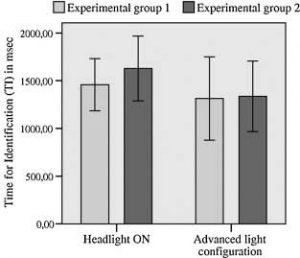A study has shown that motorcycles with a T-shaped arrangement of lights are seen and identified as a motorcycle more quickly. This may also be effective for bicycles. However, the improvement shown by this study was very small.
Method
The method used was to show people photographs, some of which contained motorbikes and see how quickly and accurately the people could identify the bikes. Some of the photo’s which contained motorbikes were photo edited so that different light configurations were simulated. In total three configurations of lights were used, a control with a normal headlight and two experimental configurations. The first experimental condition added lights at the fork and handlebars to create a T-shaped arrangement. The second experimental condition added helmet lights to the T-configuration. The photo’s which did not contain motorbikes showed other traffic scenes such as other vehicles and intersections. To gain a meaningful measure of how well drivers would identify a bike in actual driving, they were not asked to identify motorbikes. They were asked to spot the vehicles they would need to pay attention to if they were entering the traffic from a side road. The participants were not told that the focus of the study was motorbikes. The time they took to identify the bikes and their gaze behavior were both recorded.
Results
In over 99.5 percent of the photo’s shown to the participants, all of the vehicles were correctly identified. An analyses of variance (ANOVA) showed that there was a significant reduction in the time to identify motorbikes when the T-shaped lights were used. However, the benefits are very slight, especially when compared to the dramatic improvement in visibility when using retroreflective markers at the ankles and knees

Abstract:
One often discussed reason for motorcyclists’ high risk of accidents is that they are less conspicuous to other road users than are other motorised vehicles. The present paper aims to identify a front signal pattern created by additional light sources that would make motorcycles clearly and quickly distinguishable from other vehicles, and that would therefore facilitate localisation and identification of motorcycles. Results of a laboratory experiment have shown that motorcycles with a T-shaped light configuration are more quickly identified, particularly when the motorcycles are in visual competition with other motorised road users. Furthermore, analysis of gaze behavior showed that they were faster fixated by the subjects in the experiment, and the mean duration of fixations was shorter. The practical implications of this experiment and the need for further research are discussed.
Reference:
“Recognisability of different configurations of front lights on motorcycles”
Lars Rößger Katharina Hagen Jens Krzywinski Bernhard Schlag
Accident analysis and prevention. , 2012, Vol.44(1), p.82-87
Let us know what you think